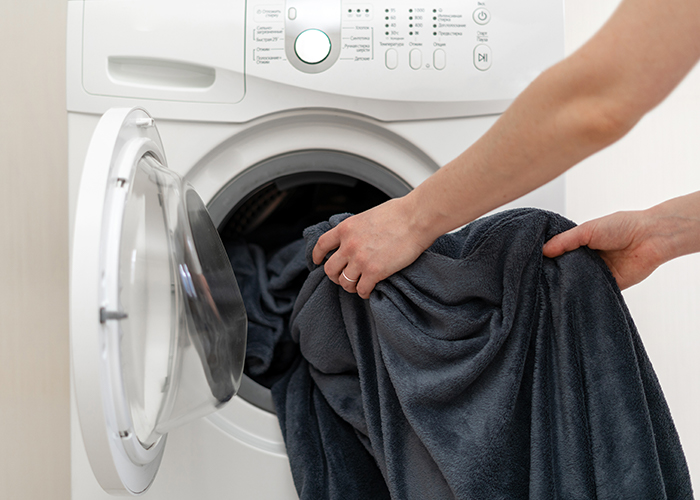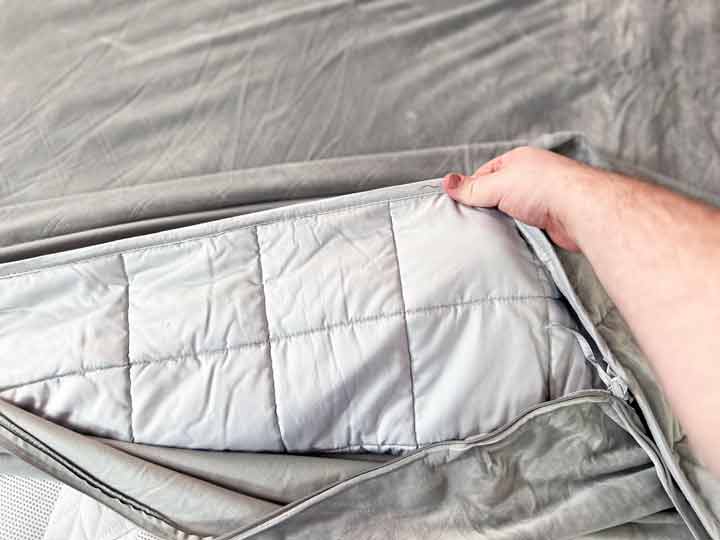Does your favorite blanket make you feel like a kid again? Maybe it’s your partner in crime during a chilly evening or a movie marathon. Unfortunately, the more you use and love your favorite blanket, the less sumptuously soft it seems. There’s a good reason your fluffy blanket is losing its softness, and with a few easy tips, you can help restore it to its former snuggly glory.
Why Do Blankets Lose Their Softness?

The main reason blankets lose their softness is improper care, especially from over-enthusiastic washing practices.
Some of the softest blankets are made from synthetic fibers, and these synthetic fibers need a little TLC in order to maintain their touchable fluffy feel.
Those fleece-y blankets that feel like heaven are often made from polyester or a polyester blend. Fleece fabric is made from fine polyester fibers woven together and brushed to mimic a sheep’s coat (hence the name). Fleece is sometimes blended with other fabrics, such as cotton, hemp, wool or rayon, to enhance its texture or appearance.
Synthetic polyester blankets can lose their softness when they’re washed incorrectly. High heat, excess detergent, and harsh chemicals can deteriorate the fibers, causing them to lose their softness. When the synthetic fabrics are damaged, their ends can curl up and create areas that feel rough.
A blanket can also lose its softness if washed with the wrong products or simply because it’s too dirty and a little over-loved.
How to Make a Blanket Soft Again
Ready to make your favorite blanket soft again? The first step is understanding what material it is made of. Synthetic materials aren’t the only ones that need special care; if your blanket is made from wool, cashmere, cotton muslin or even bamboo, it may have special instructions for care.
Your blanket should have a laundry care tag that tells you what materials it’s made of and how to wash it. If that tag was removed or is missing, give it your best guess by comparing it to similar blankets around your home.
Machine Washing
Many blankets can be cleaned in the washing machine. When machine washing, use the lowest recommended temperature to protect synthetic materials like polyester fleece. Wash in a gentle cycle and use a gentle detergent. Air-dry or machine-dry at a gentle, low-heat setting.
Hand Washing
For delicate fabrics like wool, cashmere, and mink, a gentle hand wash in a tub or deep sink using mild detergent, baking soda and vinegar can help refresh a beloved blanket without damaging the fibers. Air-dry or toss in your dryer at a gentle, low-heat setting.
Fabric Softeners
While it may seem counterintuitive, it’s best to avoid fabric softeners when aiming for soft blankets. Fabric softeners coat the fibers with chemicals and can build up over time. The more softener that gets coated onto your blanket, the less soft it will feel.
Vinegar Rinse
Instead of fabric softener, add a bit of white vinegar in its place in the wash. A vinegar rinse banishes residue and odors and makes fabrics feel super soft and silky when used as a fabric softener replacement. Don’t worry, your blanket won’t smell like vinegar.
Brushing and Combing
Did you know that brushing the fibers is how manufacturers get fleece blankets to resemble a sheep’s wooly coat? For some blankets, like fleece, a gentle brushing post-wash can help fluff up the fibers and maintain the soft texture, making your blanket feel new again.
How to Care for Blankets

When caring for your blankets, let gentleness be your guide. Whether you’re selecting the right laundry detergent, temperature or cycle, erring on the side of gentle will ensure your blanket lasts longer and feels softer to the touch.
Choose the Right Detergent
Opt for mild, eco-friendly detergents that are gentle on fibers to help maintain your blanket’s softness. Avoid harsh detergents and bleach to protect the fabric. Want your blanket to feel baby-soft? Try using a baby-friendly detergent. You also want to avoid adding detergent with a heavy hand; sometimes, using less is better. Too much detergent may not rinse away completely and can leave a soapy film behind, coating the fibers of your blanket.
Choose the Proper Washing Cycle
Soft blankets often need delicate wash and dry cycles. Selecting a gentle or delicate cycle and adhering to the manufacturer’s guidelines can significantly prolong the life and softness of your blanket.
Air-Drying vs Machine Drying
Many blankets can safely be machine-dried. However, if you do choose to dry your blanket in the machine, use a low-heat setting. Excessive heat can damage blankets made from natural or synthetic fibers. Whenever possible, air-dry your blankets to avoid the heat of dryers, which can damage the fibers. If machine drying, use a low-heat, gentle cycle.
Caring for Your Blankets
Different blankets have unique care needs. Understanding these can ensure a long, soft life for your cozy companion.
Weighted Blankets

It’s really important to know how to wash a weighted blanket before you send it through the wash. Weighted blankets often contain a fill, which could consist of microfiber beads, sand, steel, or other materials. Follow the care label closely, as incorrect washing could damage the blanket and your washing machine if the fill gets loose. Consider hand-washing and air-drying your weighted blanket for longevity.
Heated Blankets
Many modern heated blankets are washable, but older ones may not be. Before you wash a heated blanket, understand that the heating element of an electric blanket could be ruined if you don’t carefully follow the manufacturer’s instructions. If the tag is missing, refer to the manufacturer’s website for proper care instructions.
Fleece Blankets
Polyester fleece retains its softness best when washed with mild detergent and a white vinegar rinse. Air-dry or tumble-dry on a low setting. If you remove your fleece blanket from the dryer and it still isn’t soft enough, try gently brushing the fibers to separate and fluff them further.
Wool Blankets
Sheep’s wool needs extra TLC to avoid shrinking and to maintain its texture. Wool requires gentle hand-washing and air-drying to maintain its soft and luxurious feel. Avoid hot water and high heat when washing a wool blanket.
Crochet Blankets
Handmade crochet blankets thrive on gentle care—hand wash with a mild detergent and air dry to maintain their intricate patterns and softness. Tossing them into a washing machine or dryer could do permanent damage.
Proper Storage to Maintain Softness
If your blanket will get stored when not in use, you can help ensure it is soft, fluffy and ready for use next season with proper storage tips.
Use a Storage Bag
A storage bag can help protect your blankets against dirt, dust, allergens, insects and moisture when not in use. Plus, it’s an easy way to organize and store your bedding.
Don’t Crush or Compress
Fold your blankets before storing, but don’t shove, crush or compress them into a storage space. When you crush a blanket, you run the risk of damaging the fibers. Fibers that get damaged will pill and feel rough, no matter how hard you try to restore their softness.
Avoid Damp Environments
Moisture will ruin any material, including fabric. Moisture creates an environment that mold spores and insects find very appealing. If your favorite blanket is stored someplace damp, there’s a good chance you could find it covered in mold or eaten by insects by the next season.
The blankets you love the most are often the first ones to lose their cozy softness. When those blankets are hauled through every room in the house and accompany you to the great outdoors, they’ll likely get soiled quickly. It can be tempting to think that a hot wash will remove all of the dirt, but high heat can be the enemy of your blanket’s touchability.
Follow the manufacturer’s care instructions, wash gently, use mild products and store properly to ensure that your blanket remains a fluffy haven of warmth and comfort. Remember, a little TLC goes a long way in maintaining the softness and integrity of your cherished blankets. So, next time your cozy companion starts to feel a bit rough, give it the care it deserves, and it will return the favor with warmth and softness.
FAQs
Does washing a blanket make it less soft?
Washing can make a blanket less smooth if done incorrectly. Avoid hot water, harsh detergents, bleach and fabric softeners.
How do you keep blankets soft and fluffy?
Use mild detergents, wash in cool water, air-dry when possible and avoid fabric softeners to keep blankets soft and smooth.
Will washing a blanket ruin it?
Not if you follow the care label instructions. Improper washing can damage the fibers and ruin the blanket’s texture and appearance.
How do you fix a matted blanket?
To select a matted blanket, mix baking soda and white vinegar with a mild detergent and wash on the coolest and gentlest settings.
